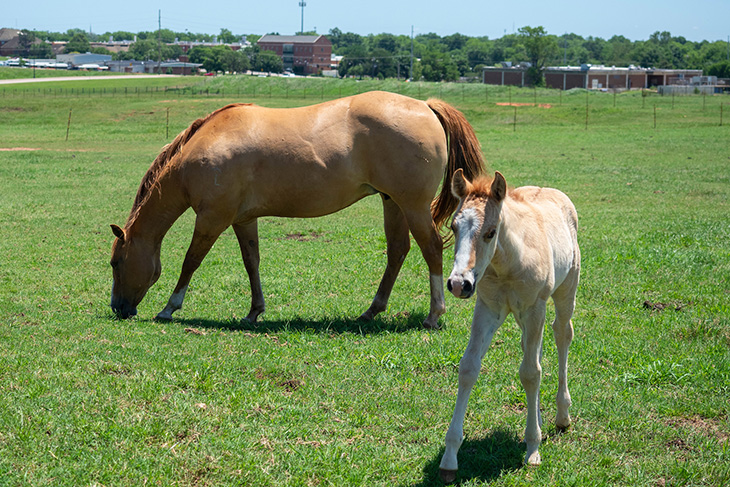
Preparation helps foaling go smoother for both mares and horse managers
Thursday, March 18, 2021
Horse owners who take a few steps to prepare for foaling can promote a smoother birthing process for their broodmares, according to Oklahoma State University Extension recommendations.
“A foaling mare should be as relaxed as possible and settled into a routine – stalled at night and turned out during the day, weather permitting,” said Kris Hiney, OSU Extension equine specialist with the university’s Department of Animal and Food Sciences. “Nighttime observation should be unobtrusive. Many horse farms make use of cameras and apps. If somebody is going to be a nighttime attendant, make sure the mare is familiarized with the person well ahead of time.”
The foaling environment should be clean, have adequate space and be reasonably quiet. A stall with dimensions of 14 feet by 14 feet or larger is recommended. Fill the stall with straw rather than shavings. A 10-inch-thick bed of straw will cut down on dust, decrease chances of infection and is easier to clean off the mare and newborn foal.
Barn lights should be regulated and not turned on and off at various intervals. An alternative to constant nighttime observation is to use a dim light in the stall, just bright enough to see the mare. Another option is to use red lights that don’t throw off a mare’s circadian rhythms.
“In-person observation of the mare should be done outside the foaling stall,” said Dr. Rosslyn Biggs, OSU Extension veterinarian and director of continuing education for the university’s College of Veterinary Medicine. “It’s critical to remember that complications during the foaling process are always an emergency. Horse managers should contact their attending veterinarian and develop a good working relationship well before foaling.”
Horse managers should not be overly concerned if a mare fails to deliver exactly on schedule. An average gestation is 330 days, and a foal born within 320 days is considered premature. Although normal gestation for a mare is 320 to 380 days, there are variations.
“Premature foals typically will require extra care and veterinary assistance,” Biggs said. “Mares that foal in less than 310 days are most likely aborting.”
The personality of the mare may change as parturition becomes imminent. The horse may appear restless and become irritable, laying her ears back at the slightest provocation. If running in a herd, the mare may distance herself from other horses. Her tail should be wrapped at this time to keep it out of the way in case problems develop during foaling and assistance is required.
“Clean flannel or gauze can be used to wrap the tail,” Hiney said. “Tight elastic wraps should not be used because circulation to the tail may be restricted.”
Fact sheets detailing research-based information about best foaling management practices are available online and through OSU Extension county offices.
Hiney recently provided additional insights about mare management, gestation length and related equine technologies on the agricultural television show SUNUP. The video segment is available online. Research about gestation length in horses is available online through the National Library of Medicine.
MEDIA CONTACT: Donald Stotts | Agricultural Communications Services | 405-744-4079 | donald.stotts@okstate.edu
